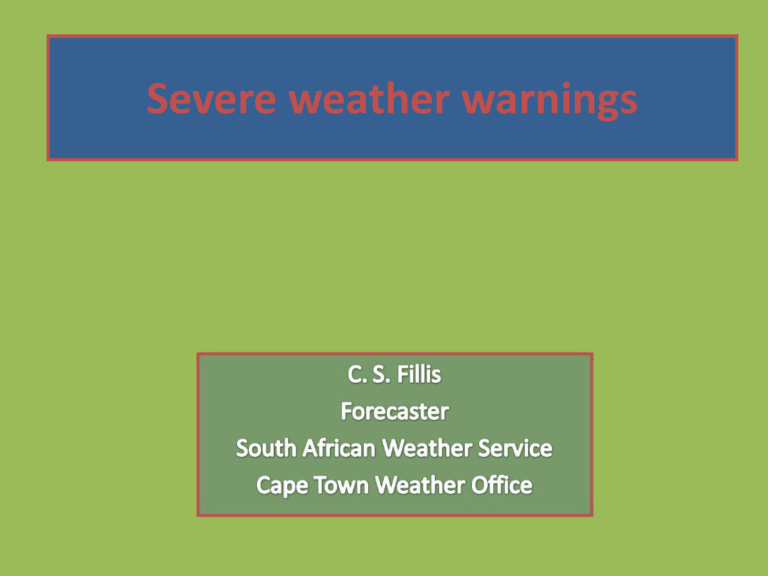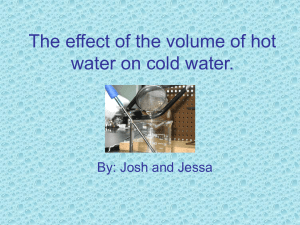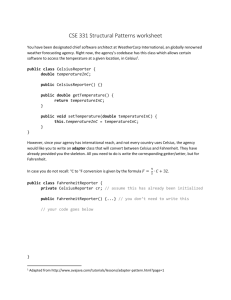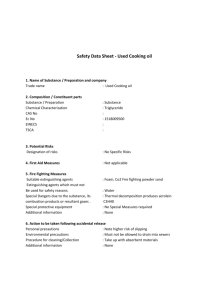Severe weather warnings - Western Cape Government

Severe weather warnings
Natural Hazard:
Some definitions
Weather or flood-related situation with potential to inflict loss or damage to the community or environment. While hazard may induce a crisis, they do not necessarily lead to disasters.
Natural Disaster: A catastrophic event caused by a natural hazard that severely disrupts the fabric of a community and usually requires intervention of government to return the community to “normality”.
Some definitions
In some instances, natural disasters can not be prevented from occurring, however their overall impact can be significantly reduced through Disaster Mitigation.
Disaster mitigation: Process of managing the “risks” associated with potential natural disasters so that loss may be minimized and even eliminated.
- Appropriate Response actions
Disaster risk: The likelihood of harmful consequences arising from the interaction of natural hazards and the community.
Some definitions
Risk = Hazard Probability x Vulnerability
Nature of Hazard: Understand hazards of the past, monitoring of present, and predicting the future.
Vulnerability: The extent of a communities susceptibility or resilience to loss or damage from a natural hazard.
Reducing disaster vulnerability requires increasing knowledge about the likelihood, consequences, imminence and presence of natural hazards, and empowering individuals, communities and public authorities with that knowledge to lower the risk before severe weather events, and respond immediately during and afterwards.
Early warning
Empower individuals and communities to respond appropriately to a threat in order to reduce the risk of death, injury, property loss and damage.
Provide early warning of weather, water and climate hazards, for operational decisions
Support risk and impact assessments to determine who is at risk and why
To improve forecasts and analyses to help reduce or remove risks
Temperature: Very Cold conditions
Maximum Temperature below 10 degrees Celsius
Minimum Temperature below -10 degrees Celsius
Cold air moving from the far south
Maximum Temperature below 10 degrees Celsius
Minimum Temperature below -10 degrees Celsius
L
EUMETSAT
MSG: Air-mass image 26 August 2008 07h00Z
L
L
Minimum Temperature below -10 degrees Celsius
EUMETSAT
MSG: Air-mass image 26 August 2008 07h00Z
• Mountains
• High lying areas
Snow
• Maximum Temperature below 10 degrees Celsius
• Felt on the skin and eventually the whole body.
Minimum Temperature below -10 degrees Celsius
EUMETSAT
MSG: Air-mass image 26 August 2008 07h00Z
Temperature: Wind chill
Sensible temperature less than or equal to
-15 degrees Celsius
Effects are worse under wet conditions
Very Cold conditions: At Risk People
Mountaineers, climbers and hikers
Increase
The sick electricity usage
Pets
Added risk of FIRES
Temperature: Very High
Maximum Temperature 40 degrees Celsius and above
Temperature: Very uncomfortable
Discomfort Index of 38 degrees Celsius and above
High temperatures and High humidity
Temperature: Effects
Maximum Temperature 40 degrees Celsius and above
Sunburn
Danger
Sports
Hikers
Traffic jams
Diminishing
Water
Resources
Temperature: Heat-wave
Three consecutive days when the Maximum temperature is expected to be at least 5 degrees higher than the average
High Maximums of the hottest month.
Temperature and Wind: Veld Fires
Weather conditions that could lead to runaway fires.
Depends on Temperature, wind conditions, humidity, condition of fuel etc.
Climate change:
Longer fire season for west coast and adjacent interior, central Western Cape
Wind: Gale force winds or higher
Winds speeds greater than 35kt or 65km/h
Major effect on fishing Industry particularly off west coast
Risk of falling, fallen and blowing debris
Wind: Widespread sandstorms
Normally in windy, low vegetative areas: West coast north of Lamberts Bay
May become more prevalent in climate change scenarios
Scouring effect
Very low visibility
Dangerous road conditions
Dangerous flying conditions
Temperature: Black frost
The freezing of plant sap that results in black appearance
Of the plants.
Farmers and
Gardeners
Manenberg, 1999
Wind: Tornadoes
Harrismith
Springbok!! In 2008
Severe Thunderstorms
Traffic jams:
Obvious danger to
Aviation
Lightning: Electricity spikes and power outages
Hail stones more than 19mm
Property damage
Crop damage
Heavy rain
80% probability of precipitation greater than 50mm over 24 hours
Very low visibility and slippery roads
Dangerous road conditions
May flood low lying areas
Flooding
Damage to property
Raging rivers
Damaged infrastructure
Erosion
Inaccessible roads
Debris
Maritime: Waves higher than 5m, 7m
Abnormal wave height
High waves
Fishing Industry
Offshore drilling
Lightning
Maritime: Tropical cyclones
Storm Surge
Huge waves
Heavy rain and flooding
Aviation: Large Hail
Aviation: Severe Turbulence and
Mountain waves
Aviation: icing and Ice accretion
Aviation: Volcanic Ash
Regional Specialist Meteorological
Strong Winds
Early warning
Strive to ensure that every person or organization at risk
• Receives the information
• Understands the information
• BELIEVES the information
• Personalizes the risk
• Make correct decisions
• Respond in a timely manner
Early warning
Effective early warning should be:
• Short, concise, understandable and actionable
• What, where, when, why, how to respond
Should be presented in several different formats – text-graphics-color coded categories-audio; should included specific actions for people to take to respond to the event.
Early warning www.capetown.dj/people/people.html
http://upload.wikimedia.org/wikipedia/commons/a/a2/Mountaineers_in_High_Tatry_mount ains_winter.jpg
http://www.jokesy.com/images/old-lady-senior-citizens-jokes1.jpg
http://happytrailsboardingkennel.com/sitebuilder/images/sick_puppy-600x319.jpg
http://weathersavvy.com/windysnow_OPT.jpg
http://ed101.bu.edu/StudentDoc/Archives/ED101fa06/mattwall/Weather%20Pictu res/thunderstorm.jpg
http://www.airliners.net/aviation-forums/general_aviation/read.main/2271578 http://www.iopara.ca/research.html





